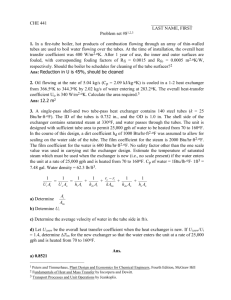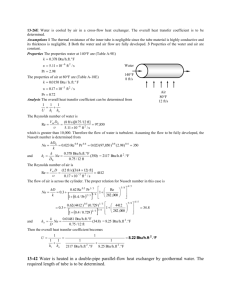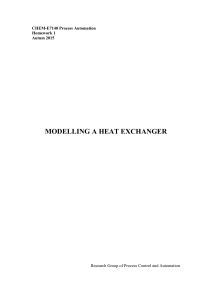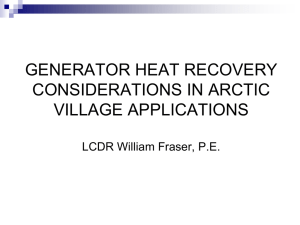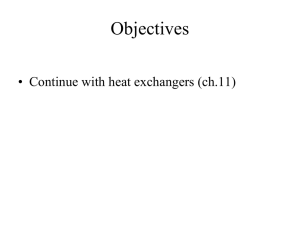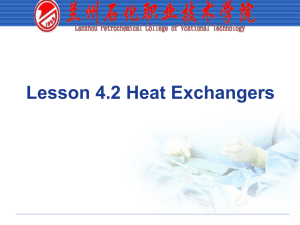April 25
advertisement
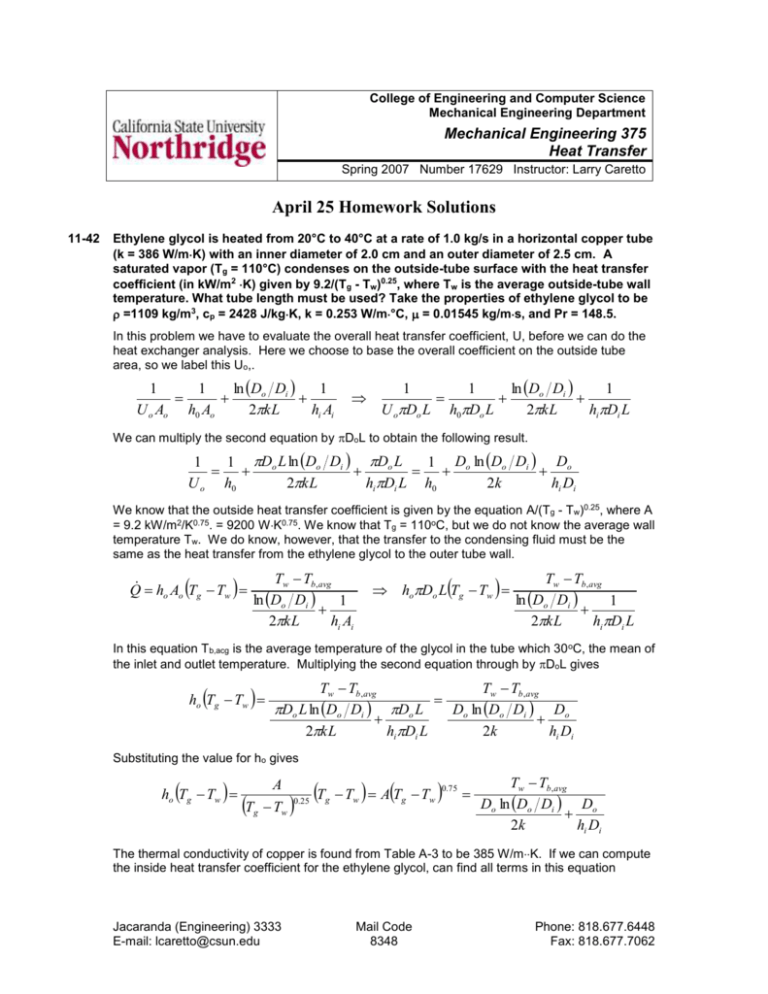
College of Engineering and Computer Science Mechanical Engineering Department Mechanical Engineering 375 Heat Transfer Spring 2007 Number 17629 Instructor: Larry Caretto April 25 Homework Solutions 11-42 Ethylene glycol is heated from 20°C to 40°C at a rate of 1.0 kg/s in a horizontal copper tube (k = 386 W/mK) with an inner diameter of 2.0 cm and an outer diameter of 2.5 cm. A saturated vapor (Tg = 110°C) condenses on the outside-tube surface with the heat transfer coefficient (in kW/m2 K) given by 9.2/(Tg - Tw)0.25, where Tw is the average outside-tube wall temperature. What tube length must be used? Take the properties of ethylene glycol to be =1109 kg/m3, cp = 2428 J/kgK, k = 0.253 W/m°C, = 0.01545 kg/ms, and Pr = 148.5. In this problem we have to evaluate the overall heat transfer coefficient, U, before we can do the heat exchanger analysis. Here we choose to base the overall coefficient on the outside tube area, so we label this Uo,. ln Do Di 1 1 1 U o Ao h0 Ao 2kL hi Ai ln Do Di 1 1 1 U oDo L h0Do L 2kL hiDi L We can multiply the second equation by DoL to obtain the following result. 1 1 D L ln Do Di Do L 1 D ln Do Di Do o o U o h0 2kL hiDi L h0 2k hi Di We know that the outside heat transfer coefficient is given by the equation A/(Tg - Tw)0.25, where A = 9.2 kW/m2/K0.75. = 9200 WK0.75. We know that Tg = 110oC, but we do not know the average wall temperature Tw. We do know, however, that the transfer to the condensing fluid must be the same as the heat transfer from the ethylene glycol to the outer tube wall. Q ho Ao Tg Tw Tw Tb,avg ln Do Di 1 2kL hi Ai hoDo LTg Tw Tw Tb ,avg ln Do Di 1 2kL hiDi L In this equation Tb,acg is the average temperature of the glycol in the tube which 30 oC, the mean of the inlet and outlet temperature. Multiplying the second equation through by DoL gives ho Tg Tw Tw Tb ,avg Tw Tb ,avg Do L ln Do Di Do L Do ln Do Di Do 2kL hiDi L 2k hi Di Substituting the value for ho gives ho Tg Tw Tw Tb ,avg A 0.75 T T A T T g w g w Do ln Do Di Do Tg Tw 0.25 2k hi Di The thermal conductivity of copper is found from Table A-3 to be 385 W/mK. If we can compute the inside heat transfer coefficient for the ethylene glycol, can find all terms in this equation Jacaranda (Engineering) 3333 E-mail: lcaretto@csun.edu Mail Code 8348 Phone: 818.677.6448 Fax: 818.677.7062 April 25 homework solutions ME 375, L. S. Caretto, Spring 2007 Page 2 except for Tw. That will give us an equation to solve for T w. We have to compute the Reynolds number to see if the flowinside the tunbe is laminar or turbulent. To do this we need the velocity. 1 kg m m 2.870 m s V 2 3 1109 kg A Di 4 m s 0.02 m 2 3 4 m VD Re 1109 kg 2.870 m 0.02 m s m3 4121 0.01545 kg ms This is a transition flow; we will use the equation for fully developed turbulent flow in this case. Here we use the Dittius-Boelter equation with a Prandtl number exponent of n = 0.4 because we are heating the fluid, to find the Nusselt number and the heat transfer coefficient, hi. Nu 0.023 Re 0.8 Pr 0.4 0.0234121 0.8 hi 148.50.4 132.5 kNu 132.5 0.253 W 1677 W 2 Di 0.02 m m K m K Substituting this value for hi and the other data for diameters and thermal conductivity into our equation for Tw gives the following computational result. A Tg Tw 0.75 T Tw 0.75 0.25 g 9200 W m2 K Tw 30 0 C 0.025 m ln 0.025 m 0.02 m 2 385 W mK m 2 K 0.025 m 1677 W 0.02 m Tw Tb, avg Do ln Do Di Do 2k hi Di Tw 30 0 C 7.24 x10 6 m 2 K 745.4 x10 6 m 2 K W W We see that the resistance of the copper tubing is small compared to the inside convection resistance and we could have neglected it. Rearranging this equation and setting Tg to its given value of 110oC gives 9200 W W Tg Tw 0.75 1329 Tw 30 0 C 2 0.75 2 m K m K 110 C T T 30 C 0.75 o w 0 0.06920 K 0.25 w Note that the units are consistent because we are dealing with temperature differences. Thus we can use a constant with units of kelvins to solve for a temperature difference in oC. Solving this equation by calculator or spreadsheet software for numerical solution of an equation gives Tw = 91.58oC. This gives the outside heat transfer coefficient, ho = 9200/(110oC – 91.58oC)0.25 = 4441 W/m2oC. We now have all the information we need to compute the overall heat transfer coefficient. April 25 homework solutions ME 375, L. S. Caretto, Spring 2007 Page 3 1 1 D ln Do Di Do o U o h0 2k hi Di m 2 K 0.025 m ln 0.025 m 0.02 m m 2 K 0.025 m 9.706 x10 4 m 2 K 385 W 4441 W 1677 W 0.02 m W 2 m K Taking the reciprocal gives Uo = 1030 W/m2oC. We can find the length by finding the heat U A T . First, we can compute the heat transfer by transfer area using the equation that Q o o lm applying the first law energy balance to the glycol flow. 1 kg 2428 J W s Q m c p T2 T1 40o C 20o C 48560 W s kg K J Next we compute the log-mean temperature difference for this heat exchanger. Although we are not told if it is parallel flow or counter flow, that does not matter since the hot side temperature is a constant. Tln T h Tc ,in Th Tc ,out T Tc ,in ln h T T h c , out 110 C 20 C 110 C 40 C 79.58 C o o o o o 110 C 20 C ln o o 110 C 40 C o o We can now find the desired length. Q U o Ao Tlm U oDo LTlm L Q 48560 W 1030 W U oDo Tlm 0.025 m 79.58 o C 2 m K L = 7.54 m 11-46 Steam in the condenser of a steam power plant is to be condensed at a temperature of 50°C (hfg = 2383 kJ/kg) with cooling water (cp = 4180 J/kg°C) from a nearby lake, which enters the tubes of the condenser at 18°C and leaves at 27°C. The surface area of the tubes is 42 m2, and the overall heat transfer coefficient is 2400 W/m2°C. Determine the mass flow rate of the cooling water needed and the rate of condensation of the steam in the condenser. From the information given on temperatures and area, we can compute the heat transfer using the usual UAT . Once we know the heat equation Q lm transfer we can compute the required mass flow rates by first law energy balances. Since the temperature of the steam does not change we can write our log-mean temperature difference equation as follows. April 25 homework solutions Tln T h ME 375, L. S. Caretto, Spring 2007 Tc ,in Th Tc ,out T T ln h c ,in Th Tc ,out Page 4 50 C 18 C 50 C 27 C 27.3 C o o o o o 50 C 18 C ln o o 50 C 27 C o o We can now compute the heat transfer. 2400 W Q UATlm 2 o 42 m 2 27.3o C 3.752 x10 6 W m C We can use this heat transfer to compute the mass flow rates of the cooling water and the condensing steam. Q m coolingc p T2 T1 water Q m steamh fg 1J 3.752 x10 6 W Q W S = 73.1 kg/s m cooling 4184 J c p T2 T1 water 27 o C 18o C o kg C m steam Q 3.752 x10 6 W = 1.15 kg/s h fg 2383 kJ 1000 W s kg kJ 11-49E A 1-shell-pass and 8-tube-passes heat exchanger is used to heat glycerin (cp = 0.60 Btu/lbmoF) from 65oF to 140oF by hot water (cp = 1.0 Btu/ lbmoF) that enters the thin-walled 0.5-in-diameter tubes at 175oF and leaves at 120oF. The total length of the tubes in the heat exchanger is 500 ft. The convection heat transfer coefficient is 4 Btu/h ft2oF on the glycerin (shell) side and 50 Btu/hft2oF on the water (tube) side. Determine the rate of heat transfer in the heat exchanger (a) before any fouling occurs and (b) after fouling with a fouling factor of 0.002 Btu/hft2oF /Btu on the outer surfaces of the tubes. From the data given we can compute the heat transfer coefficient by assuming that the thinwalled tubes do not add to the overall resistance composing the heat transfer coefficient. ln Do Di 1 1 1 U o Ao h0 Ao 2kL hi Ai 1 1 1 h ft 2 o F h ft 2 o F 0.27 h ft 2 o F U h0 hi 4 Btu 50 Btu Btu Taking the reciprocal gives U = 3.704 Btu/hft2oF. From this U value and the other given data, UAFT where F is the correction we can find the heat transfer by the usual equation, Q lm factor to account for the 8 tube passes in this heat exchanger. We compute the log-mean temperature difference for a counter-flow heat exchanger (the basis for the correction factor method) as follows. Tln T h ,out Tc ,in Th ,in Tc ,out T T ln h ,out c ,in Th ,in Tc ,out 120 C 65 C 175 C 140 C 44.25 C o o o o o 120 C 65 C ln o o 175 C 140 C o o We have to compute the ratios R and P to determine the correction factor. April 25 homework solutions ME 375, L. S. Caretto, Spring 2007 Page 5 Ttube,out Ttube,in t 2 t1 120 o F 175 o F P 0.5 Tshell,in Ttube,in T1 t1 65 o F 175 o F T T T T 65 o F 140 o F R shell,in tube,in 1 2 1.36 Ttube,out Ttube,in t 2 t1 120 o F 175 o F From Figure 11.18(a) for one shell pass and any multiple of 2 tube passes we find F = 0.60 for these values of R and P. We can now find the heat transfer. 3.704 Btu Q UAFTlm 523.6 ft 2 0.6 44.25o F 51.5x104 Btu/h 2 o h ft F With fouling we have to add the fouling factor to our calculation of the overall heat transfer coefficient U. 2 o 1 1 1 h ft 2 o F 0.002 h ft F h ft 2 o F 0.272 h ft 2 o F R f ,i U h0 hi 4 Btu Btu 50 Btu Btu Taking the reciprocal gives U = 3.676 Btu/hft2oF. The other data (correction factor and logmean temperature difference) do not change and we find the heat transfer as follows. 3.676 Btu Q UAFTlm 523.6 ft 2 0.6 44.25o F 51.2x104 Btu/h 2 o h ft F 11-90 Cold water (cp = 4.18 =J/kg°C) enters a cross-flow heat exchanger at 14°C at a rate of 0.35 kg/s where it is heated by hot air (cp = 1.0 kJ/kg°C) that enters the heat exchanger at 65°C at a rate of 0.8 kg/s and leaves at 25°C. Determine the maximum outlet temperature of the cold water and the effectiveness of this heat exchanger. There are two possible limits to the maximum water temperature. The first is simply the temperature of the hot fluid entering, 65oC. However, it is possible that the maximum heat transfer will give a lower limit for temperature. We compute the maximum heat transfer by computing the products of mass flow rate times heat capacity and finding which is the smaller. Ch m h c p ,h Cc m c c p ,c 0.8 kg 1.0 kJ 1 kW s 0.8 kW o s kg o C kJ C 0.35 kg 4.18 kJ 1 kW s 1.463 kW o s kg o C kJ C So Cmin = Ch = 0.8 kW/oC. We use this to compute the maximum heat transfer. 0.8 kW Q max C min Th ,in Tc ,in o 65 o C 14 o C 40.80 kW C This maximum rate of heat transfer gives the maximum outlet temperature of the water found as follows form the usual first law energy balance. Q 40.80 kW Q max Cc Tc ,max out Tc ,in Tc ,max out Tc ,in max 14 o C = 41.9oC 1.463 kW Cc o C April 25 homework solutions ME 375, L. S. Caretto, Spring 2007 Page 6 The effectiveness is the actual heat transfer divided by the maximum heat transfer. The actual heat transfer can be found from the inlet and outlet temperature of the air. C T T Q air air,in air,outn Qmax Qmax 11-93 0.8 kW 65o C 25 o C o C = 0.784 40.80 kW Hot oil (cp = 2200 J/kg°C) is to be cooled by water (cp = 4180 J/kg°C) in a 2-shell-passes and 12-tube-passes heat exchanger. The tubes are thin-walled and are made of copper with a diameter of 1.8 cm. The length of each tube pass in the heat exchanger is 3 m, and the overall heat transfer coefficient is 340 W/m2°C. Water flows through the tubes at a total rate of 0.1 kg/s, and the oil through the shell at a rate of 0.2 kg/s. The water and the oil enter at temperatures 18°C and 160°C, respectively. Determine the rate of heat transfer in the heat exchanger and the outlet temperatures of the water and the oil. We compute the maximum heat transfer by first computing the products of mass flow rate times heat capacity and finding which is the smaller. C h m h c p ,h 0.2 kg 2200 kJ 1 kW s 440 W o s kJ kg o C C Cc m c c p ,c 0.1 kg 4180 kJ 1 kW s 418 W o s kJ kg o C C So Cmin = Cc = 418 W/oC. We use this to compute the maximum heat transfer. 418 W Q max C min Th,in Tc ,in o 160 o C 18o C 5.935 x10 4 W C In order to find the heat transfer we have to find the heat exchanger effectiveness. We do this by computing the NTU and using the charts that give the effectiveness as a function of NTU and the ratio of Cmin/Cmax. The surface area is required to compute the NTU. The heat exchanger in this problem has 12 tube passes, each of which is 3 m long, with a diameter of 1.8 cm = 0.018 m. Thus the total heat transfer surface area is found as follows. As NDL 12 0.018 m 2 m 2.04 m 2 340 W 2.04 m 2 UAs m 2 o C NTU 1.659 418 W Cmin o C C min C max 418 W o C 0.95 440 W o C For these values of NTU and Cmin./Cmax, we find = 0.061 from Figure 11-26(d) on page 637. The actual heat transfer is the product of the maximum heat transfer and the heat exchanger effectiveness. Q Q max 0.61 5.935 x10 4 W = 3.62x104 W 11-118 The condenser of a large power plant is to remove 500 MW of heat from steam condensing at 30°C (hfg = 2431 kJ/kg). The cooling is to be accomplished by cooling water (cp = 4180 J/kg°C) from a nearby river, which enters the tubes at 18°C and leaves at 26°C. The tubes of the heat exchanger have an internal diameter of 2 cm, and the overall heat transfer April 25 homework solutions ME 375, L. S. Caretto, Spring 2007 Page 7 coefficient is 3500 W/m2°C. Determine the total length of the tubes required in the condenser. What type of heat exchanger is suitable for this task? From the data given we can compute the required area by computing the log mean temperature difference. Tln Th, out Tc,in Th,in Tc, out Th, out Tc, in ln T T h, in c, out 30 C 18 C 30 C 26 C 7.28 C o o o o o 30 C 18 C ln o 30 C 26 o C o o If we assume a simple configuration so that there is no correction factor, we can compute the desired tube length. Q U o Ao Tlm U o Do LTlm Q 500 x10 6 W L U o Do Tlm 3500 W 0.02 m 7.28o C 2 m K L = 3.123x105 m This length of tubes will obviously require a heat exchanger with several tube passes. After deciding on a final design we would have to recomputed the heat transfer to account for the correction factor in a multi-pass heat exchanger.
